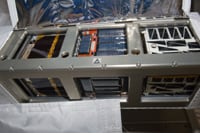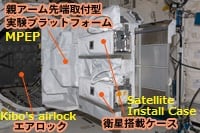Overview

JEM Small Satellite Orbital Deployer (J-SSOD) is a mechanism for deploying small satellites. It is designed in accordance with CubeSat design specification (10cm×10cm×10cm). The satellites installed in J-SSOD is transferred from the Japanese Experiment Module Kibo's airlock to space and are released on orbit. J-SSOD is composed of the Satellite Install Cases, Separation Mechanism and Electrical Box.
In order to respond the increased demands for the CubeSat deployments, a reusable satellite orbital deployer (JEM Small Satellite Orbital Deployer Re-usabla: J-SSOD-R) has been introduced in March 2021, which accommodates the maximum 24U (6U per each deployer) capability.
In May 2018, as a new step to enhance the commercial utilization of Kibo, JAXA selected SpaceBD Inc. and Mitsui Bussan Aerospace Co., Ltd as the J-SSOD service provider. Please refer here for satellite deployment services by these service providers.
Specifications
| Item | Spacification |
| Installable satellite size | CubeSat: 1U、2U、3U、4U、5U、6U、W6U* 50kg class satellite:55×35×55cm |
| Installable satellite mass | CubeSat: 1.33 kg or less per 1U, W6U size satellite is 6.8kg or less 50kg class satellite: Less than 50kg |
| Insertion orbit | Elliptical orbit with altitude of 380 km - 420 km (depends on ISS altitude) Inclination: 51.6° |
| Ballistic coefficient | CubeSat: 120kg/m2 or less 50kg class satellite: 100kg/m2 or less (To prevent collisions between the satellites and the ISS, it makes satellites drop faster than ISS after its deployment.) |
| Insertion direction | Nadir-aft 45° from the ISS nadir side, in terms of ISS body coordinate system |
| Insertion velocity | CubeSat: 0.77~1.7m/sec 50kg class satellite: 0.4m/sec (Depends on satellite mass) |
| Life expectancy on orbit | About a year (depends on ballistic coefficient, released altitude, or solar activity, etc.) |
* 1U~6U : 10cm(W)×10cm(D), Height: 1U: 10cm, 2U: 20cm, 3U: 30cm, 4U: 40cm, 5U: 50cm, 6U:60cm, W6U: 10cm(W)×20cm(D)×30cm(H)
Please refer here for detailed technical requirements, etc. for J-SSOD.
CubeSat deployment mission using J-SSOD
CubeSats are released from Kibo external platform, taking advantage of its unique function having both airlock and robotic arm among modules on the ISS.
Mission Procedure


- Satellite Install Cases with pre-installed CubeSats are delivered to the ISS as part of spaceship cargo.
- On Kibo, Satellite Install Cases are installed on the MPEP. Then the MPEP is installed on the airlock slide table. Mechanism checkout and preparation are conducted.
- The J-SSOD attached with MPEP is transferred to the outboard. Then, Kibo's robotic arm Japanese Experiment Module Remote Manipulator System (JEMRMS) grapples the MPEP and transfers it to the releasing point.
- MPEP is faced to the direction of nadir-aft 45°, opposite side of the ISS travel direction. Then, the satellites is deployed from the J-SSOD by internal spring force when the J-SSOD receives the commands from the ground operator.
Compared with satellites launched by rockets, J-SSOD mission has the following advantages.
- Lower vibration environment during the launch phase
- Multiple launch opportunities a year
CubeSats deployed using J-SSOD
International Collaborations
JAXA continues to make international contributions with UNOOSA through the KiboCUBE initiative in utilizing the ISS Kibo for the world. KiboCUBE aims to provide educational or research institutions from developing countries of United Nations membership with opportunities to deploy, from the ISS Kibo, cube satellites (CubeSats) which they develop and manufacture.
Unless specified otherwise, rights to all images belong to ©JAXA



